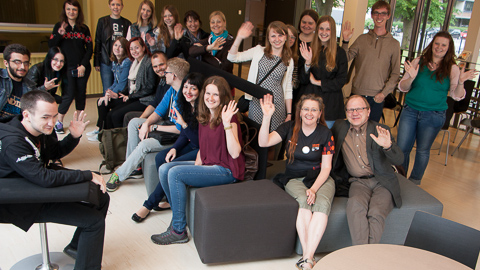CIMO Students Learn the History of Finland in Three Weeks
Why is Finland not part of NATO? How did Finland inspire patriotism with art? What was Finns' attitude towards the evacuees after the war? The 24 European students studying in Turku have a long list of questions, which the teachers of Finnish History try to answer. CIMO's first course on Finnish history is in progress.

The Department of Finnish History is doing its best to encompass the Finnish history and present-day situation into a three-week summer course. The course has 24 participants from all over Europe.
The Janus lecture hall is full of students from different parts of Europe. After a strict application process, 24 Finnish language and culture students were selected to the three-week intensive course. The goal is to cover the entire history of Finland.
– In the beginning, there was ice, Wojtsek Tatarynowicz crystallises the starting point of the first lecture.
The course covers the period from Ice Age to the beginning of Middle Ages in a few hours, after that the pace slows down. The emphasis is on the break from Russia and the independent Finland.
– In addition to the lectures, the course includes tutorials where students have the opportunity to concentrate on the topics that remain unclear after the lecture. In the tutorials, the students solve problems and discuss interpretations of history as well as the special characteristics of Finland. We also visit historic attractions, such as the Aboa Vetus Museum, Turku Castle and the island of Seili. At the end of the course, each student writes an essay on an optional topic, says Postdoctoral Researcher Suvianna Seppälä.
Discussing What the Books Do Not Cover
The course is first of its kind. Every year, CIMO, an expert organisation in international mobility and co-operation, buys courses from the Finnish universities for European university students, but previously they have concentrated on the Finnish language. This year, the organisation wanted to offer a course in Finnish history as well. The University of Turku won the bid and the students consider it to be a stroke of luck.
– Turku has had such a major significance in the Finnish history of Finland. Finnish history should be taught here, says Peter Bányai who hails from Romania.
The students were selected through a strict application process. Among other things, they had to disclose what they wanted to learn. Bányai has three big questions: what is Finland's true relationship with Russia like, why isn't Finland part of NATO and why does Finland wants to leave the EU.
– I have followed the news in Romania, which claim that Finland wants to withdraw from the EU. Why?, asks Bányai.
For Hungarian Meri Juhos, the information that is not included in history books is the most important. She is especially interested in finding out why art history and history go hand in hand in Finland when in many other countries they are rather far removed from each other. Wojtsek Tatarynowicz is interested in Finnish folklore, such as Kalevala and traditional musical instruments.
Providing the Latest Information
Professor of Finnish History Timo Myllyntaus listens to the students' questions and wishes with interest. He says that that the participants expect information, but also interpretations. The Department has arranged no less than 11 teachers to the course. Each will share the latest information from their area of expertise.
– The course open new possibilities also for us. Our doctoral candidates gain experience in teaching and we have used brand new technology on the course for the first time, says Myllyntaus.
In addition to learning about the Finnish history, Ivona Mendelová from Slovakia is looking forward to improving her language skills. The course is held entirely in Finnish and the participants strive to use it on their free time as well. Philipp Seuferling highlights the importance of discussion.
– It pushes science forward, Seuferling says.
In addition to the history course, CIMO has ordered two Finnish language courses from the University for 72 students. All in all, CIMO offers summer courses for over 200 European students and 96 of them are studying in Turku this year.
Text and photos: Erja Hyytiäinen
Translation: Mari Ratia